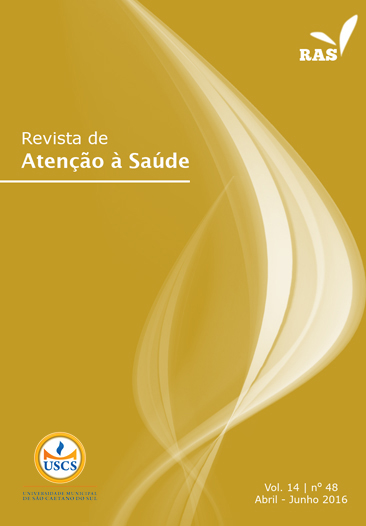Comportamento da distribuição do suporte de peso em pé em pessoas com hemiparesia crônica: revisão com metanálise
DOI:
https://doi.org/10.13037/ras.vol14n48.3240Palavras-chave:
Transtornos cerebrovasculares, hemiplegia, equilíbrio postural, suporte de carga, revisão.Resumo
Embora seja relatada a ideia de que pessoas com hemiparesia crônica possuem distribuição assimétrica do suporte de peso em pé, algumas evidências também apontam distribuições simétricas nessa população. Esta revisão teve por objetivo levantar pesquisas que investigaram a distribuição do suporte de peso em pé em sujeitos que adquiriram hemiparesia crônica decorrente de acidente vascular encefálico (AVE) identificando qual comportamento de suporte de peso foi descrito pelos autores para essa população. Foram consultadas as bases de dados PubMed, EMBASE, Cochrane, CINAHL e SciELO, até outubro de 2015. Das referências selecionadas foram destacadas as informações: (1) medidas de distribuição do suporte de peso; (2) equipamentos utilizados para medir essa distribuição; (3) informações disponíveis sobre as propriedades psicométricas do instrumento utilizado e (4) ideia apresentada sobre o tipo de distribuição no suporte de peso. Dentre as referências encontradas, aquelas que apresentaram dados obtidos a partir de balanças digitais e que permitiam o cálculo de uma razão de simetria foram utilizadas para metanálise. Observou-se na maioria dos estudos, assim como mencionado previamente, que prevaleceu a ideia de que os indivíduos com hemiparesia crônica possuem distribuição assimétrica do suporte de peso com sobrecarga do hemicorpo não parético. No entanto, a heterogeneidade dos estudos, a falta de parâmetros para se definir quais são os limites do que seria simetria no suporte de peso e as poucas informações sobre as propriedades psicométricas dos instrumentos utilizados apontam para necessidade de estudos adicionais.
Downloads
Referências
Cheng PT, Liaw MY, Wong MK, Tang FT, Lee MY, Lin PS. The sit-to-stand movement in stroke patients and its correlation with falling. Arch Phys Med Rehabil. 1998;79(9):1043-6.
Genthon N, Rougier P, Gissot AS, Froger J, Pelissier J, Perennou D. Contribution of each lower limb to upright standing in stroke patients. Stroke. 2008;39(6):1793-9.
Geurts AC, Haart M, Nes IJ van, Duysens J. A review of standing balance recovery from stroke. Gait Posture. 2005;22(3):267-81.
Tyson SF, Hanley M, Chillala J, Selley A, Tallis RC. Balance disability after stroke. Phys Ther. 2006;86(1):30-8.
Martins EF, Araujo Barbosa PH, Menezes LT, Sousa PH, Costa AS. Is it correct to always consider weight-bearing asymmetrically distributed in individuals with hemiparesis? Physiother Theory Pract. 2011;27(8):566-71.
Chagas EF, Tavares MCGCF. A simetria e transferência de peso do hemiplégico: relação dessa condição com o desempenho de suas atividades funcionais. Fisioter. Pesqui. 2001;8(1):40-50.
Camargos AC, Rodrigues-de-Paula-Goulart F, Teixeira-Salmela LF. The effects of foot position on the performance of the sit-to-stand movement with chronic stroke subjects. Arch Phys Med Rehabil. 2009;90(2):314-9.
Teixeira-Salmela LF, Lima RCM, Lima LAO, Morais SG, Goulart F. Assimetria e desempenho funcional em hemiplégicos crônicos antes e após programa de treinamento em academia. Rev Bras Fisioter. 2005;9(2):227-33.
Martins EF, Barbosa PHFdeA, Menezes LT, Sousa PHC, Costa AS. Comparação entre medidas de descarga, simetria e transferência de peso em indivíduos com e sem hemiparesia. Fisioter Pesqui. 2011;18(3):228-34.
Menezes LTd, Barbosa PHFdA, Costa AS, Mundim AC, Ramos GC, Paz CCdSC, et al. Baropodometric technology used to analyze types of weight-bearing during hemiparetic upright position. Fisioter. Movi. 2012; 25(3):583-94.
Wells GA, Shea B, O’Connell D, Peterson JVW, Losos M, et al. The Newcastle-Ottawa Scale (NOS) for assessing the quality of nonrandomised studies in meta-analyses. [acesso em 2013 Sept. 1]; Available from: http://www.ohri.ca/programs/clinical_epidemiology/nosgen.pdf.
Maher CG, Sherrington C, Herbert RD, Moseley AM, Elkins M. Reliability of the PEDro scale for rating quality of randomized controlled trials. Phys Ther. 2003;83(8):713-21.
Marigold DS, Eng JJ. The relationship of asymmetric weight-bearing with postural sway and visual reliance in stroke. Gait Posture. 2006;23(2):249-55.
Itotani K, Murakami M, Itotani M, Nagai A, Imabori Y, Fujimoto K, Tanaka M, Kato J. Relationship between the weight-bearing ratio on the affected lower extremity and gait ability using a portable electronic foot sensor shoe (Step Aid®) in hemiplegic stroke patients. J. Phys. Ther. Sci. 2015;27(2):321-3.
Chen HY, Wing AM. Independent control of force and timing symmetry in dynamic standing balance: Implications for rehabilitation of hemiparetic stroke patients. Hum Mov Sci. 2012;31(6):1660-9.
Lee H, Kim H, Ahn M, You Y. Effects of proprioception training with exercise imagery on balance ability of stroke patients. J Phys Ther Sci. 2015 Jan;27(1):1-4.
Park CS, Kang KY. The effects of additional action observational training for functional electrical stimulation treatment on weight bearing, stability and gait velocity of hemiplegic patients. J. Phys. Ther. Sci. 2013;25(3):1173-5.
Song G, Hwangbo G. The effect of a rehabilitational sliding machine and conventional neurological physical therapy on the balance of patients with hemiplegia. J. Phys. Ther. Sci. 2015;27(1):171-3.
Hung JW, Chou CX, Hsieh YW, Wu WC, Yu MY, Chen PC, Chang HF, Ding SE. Randomized comparison trial of balance training by using exergaming and conventional weight-shift therapy in patients with chronic stroke. Arch Phys Med Rehabil. 2014;95(9):1629-37.
Adegoke BO, Olaniyi O, Akosile CO. Weight bearing asymmetry and functional ambulation performance in stroke survivors. Glob J Health Sci. 2012;4(2):87-94.
Don Kim K, Lee HJ, Lee MH, Hwangbo G. Effect of ankle-foot orthosis on weight bearing of chronic stroke patients performing various functional standing tasks. J Phys. Ther. Sci. 2015;27(4):1059-61.
Mansfield A, Danells CJ, Zettel JL, Black SE, McIlroy WE. Determinants and consequences for standing balance of spontaneous weight-bearing on the paretic side among individuals with chronic stroke. Gait Posture. 2013;38(3):428-32.
Lewek MD, Bradley CE, Wutzke CJ, Zinder SM. The relationship between spatiotemporal gait asymmetry and balance in individuals with chronic stroke. J Appl Biomech. 2014;30(1):31-6.
Eng JJ, Chu KS. Reliability and comparison of weight-bearing ability during standing tasks for individuals with chronic stroke. Arch Phys Med Rehabil. 2002;83(8):1138-44.
Aruin AS, Hanke T, Chaudhuri G, Harvey R, Rao N. Compelled weightbearing in persons with hemiparesis following stroke: the effect of a lift insert and goal-directed balance exercise. J Rehabil Res Dev. 2000;37(1):65-72.
Peurala SH, Könönen P, Pitkänen K, Sivenius J, Tarkka IM. Postural instability in patients with chronic stroke. Restor Neurol Neurosci. 2007;25(2):101-8.
Lisinski P, Huber J, Gajewska E, Szlapinski P. The body balance training effect on improvement of motor functions in paretic extremities in patients after stroke. A randomized, single blinded trial. Clin Neurol Neurosurg. 2012;114(1):31-6.
Marklund I, Klassbo M. Effects of lower limb intensive mass practice in poststroke patients: single-subject experimental design with long-term follow-up. Clin Rehabil. 2006;20(7):568-76.
Pereira LC, Botelho AC, Martins EF. Relationships between body symmetry during weight-bearing and functional reach among chronic hemiparetic patients. Rev Bras Fisioter. 2010;14(3):229-66.
Balthazar RB, de Sousa PHC, de Araujo Barbosa PHF, de Menezes LT, Costa AS, Carneiro DVA, da Silva Marães VRF, Martins EF. Could heart rate variability be associated with weight-bearing asymmetries in cerebrovascular diseases? International Journal of Case Reports and Images 2012;3(2):1-5.
Hurkmans HL, Bussmann JB, Benda E, Verhaar JA, Stam HJ. Techniques for measuring weight bearing during standing and walking. Clin Biomech (Bristol, Avon). 2003;18(7):576-89.
Bohannon RW, Tinti-Wald D. Accuracy of weightbearing estimation by stroke versus healthy subjects. Percept Mot Skills. 1991;72(3 Pt 1):935-41.
Bohannon RW, Waters G, Cooper J. Perception of unilateral lower extremity weightbearing during bilateral upright stance. Percept Mot Skills. 1989;69(3 Pt 1):875-80.
Rothstein JM. Measurement in Physical Therapy. New York: Churchill Livingstone; 1985.
Winstein CJ, Pohl PS, Cardinale C, Green A, Scholtz L, Waters CS. Learning a partial-weight-bearing skill: effectiveness of two forms of feedback. Phys Ther. 1996;76(9):985-93.
Scianni A, Teixeira-Salmela LF, Ada L. Challenges in recruitment, attendance and adherence of acute stroke survivors to a randomized trial in Brazil: a feasibility study. Rev Bras Fisioter. 2012;16(1):40-5.
Dickstein R, Nissan M, Pillar T, Scheer D. Foot-ground pressure pattern of standing hemiplegic patients. Major characteristics and patterns of improvement. Phys Ther. 1984;64(1):19-23.
Lu RR, Li F, Wu Y, Hu YS, Xu XL, Zou RL, Hu XF. Demonstration of posturographic parameters of squat-stand activity in hemiparetic patients on a new multi-utility balance assessing and training system. J Neuroeng Rehabil. 2013;10:37. doi: 10.1186/1743-0003-10-37.
Babyar SR, Peterson MG, Bohannon R, Perennou D, Reding M. Clinical examination tools for lateropulsion or pusher syndrome following stroke: a systematic review of the literature. Clin Rehabil. 2009;23(7):639-50.
Johannsen L, Broetz D, Karnath HO. Leg orientation as a clinical sign for pusher syndrome. BMC Neurol. 2006;6:30. doi: 10.1186/1471-2377-6-30.
Downloads
Publicado
Edição
Seção
Licença
Proposta de Política para Periódicos que oferecem Acesso Livre Adiado
Autores que publicam nesta revista concordam com os seguintes termos:
- Autores mantém os direitos autorais e concedem à revista o direito de primeira publicação, com o trabalho licenciado simultaneamente sob uma licença
https://creativecommons.org/licenses/by-nc-nd/4.0/, permitindo o compartilhamento do trabalho com reconhecimento da autoria do trabalho e publicação inicial nesta revista.
- Autores têm autorização para assumir contratos adicionais separadamente, para distribuição não-exclusiva da versão do trabalho publicada nesta revista (ex.: publicar em repositório institucional ou como capítulo de livro), com reconhecimento de autoria e publicação inicial nesta revista.
- Autores têm permissão e são estimulados a publicar e distribuir seu trabalho online (ex.: em repositórios institucionais ou na sua página pessoal) a qualquer ponto antes ou durante o processo editorial, já que isso pode gerar alterações produtivas, bem como aumentar o impacto e a citação do trabalho publicado (Veja O Efeito do Acesso Livre).






